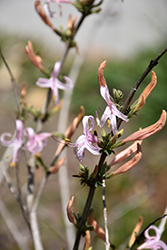It's all about ...
plants

Height: 8 feet
Spread: 12 feet
Sunlight:
![]()
Hardiness Zone: 8b
Other Names: Dwarf Desert Honeysuckle, Pinkie Anisacanth
Description:
A sprawling native Texas shrub, producing vivid pink tubular flowers with recurved lobes in early spring, before the foliage, then occasionally in summer and fall; adaptable and very drought tolerant, handles reflected heat well
Ornamental Features
Pinky Anisacanthus features showy pink tubular flowers at the ends of the branches in early spring before the leaves. Its pointy leaves remain green in colour throughout the season.
Landscape Attributes
Pinky Anisacanthus is an open multi-stemmed perennial with a mounded form. Its relatively fine texture sets it apart from other garden plants with less refined foliage.
This is a relatively low maintenance plant, and should only be pruned after flowering to avoid removing any of the current season's flowers. It is a good choice for attracting bees, butterflies and hummingbirds to your yard, but is not particularly attractive to deer who tend to leave it alone in favor of tastier treats. Gardeners should be aware of the following characteristic(s) that may warrant special consideration;
- Spreading
- Self-Seeding
Pinky Anisacanthus is recommended for the following landscape applications;
- Mass Planting
- Hedges/Screening
- Rock/Alpine Gardens
- General Garden Use
- Naturalizing And Woodland Gardens
Planting & Growing
Pinky Anisacanthus will grow to be about 8 feet tall at maturity, with a spread of 12 feet. It tends to be leggy, with a typical clearance of 1 foot from the ground, and should be underplanted with lower-growing perennials. Although it is technically a woody plant, this fast-growing plant can be expected to behave as a perennial in our climate if planted outdoors over the winter, usually regrowing from its base (crown) the following year. As such, gardeners should take into consideration that it will perform differently than it would in its native habitat.
This plant should only be grown in full sunlight. It prefers to grow in average to dry locations, and dislikes excessive moisture. It is considered to be drought-tolerant, and thus makes an ideal choice for a low-water garden or xeriscape application. It is not particular as to soil pH, but grows best in sandy soils. It is highly tolerant of urban pollution and will even thrive in inner city environments. Consider applying a thick mulch around the root zone in winter to protect it in exposed locations or colder microclimates. This species is native to parts of North America..
This plant is not reliably hardy in our region, and certain restrictions may apply; contact the store for more information.
